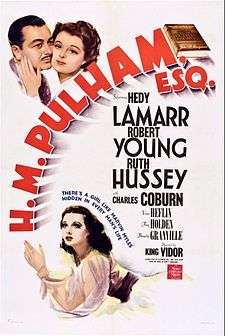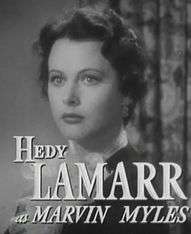H. M. Pulham, Esq.
H. M. Pulham, Esq. is a 1941 American drama film directed by King Vidor and starring Hedy Lamarr, Robert Young, and Ruth Hussey. Based on the novel H. M. Pulham, Esq. by John P. Marquand, the film is about a middle-aged businessman who has lived a conservative life according to the routine conventions of society, but who still remembers the beautiful young woman who once brought him out of his shell. Vidor co-wrote the screenplay with his wife, Elizabeth Hill Vidor. The film features an early uncredited appearance by Ava Gardner. In February 2020, the film was shown at the 70th Berlin International Film Festival, as part of a retrospective dedicated to King Vidor's career.[1]
| H. M. Pulham, Esq. | |
|---|---|
 Theatrical Film Poster | |
| Directed by | King Vidor |
| Produced by | King Vidor |
| Screenplay by | King Vidor Elizabeth Hill Vidor |
| Based on | H. M. Pulham, Esq. by John P. Marquand |
| Starring | Hedy Lamarr Robert Young Ruth Hussey Charles Coburn |
| Music by | Bronislau Kaper |
| Cinematography | Ray June |
| Edited by | Harold Kress |
| Distributed by | Metro-Goldwyn Mayer |
Release date |
|
Running time | 120 minutes |
| Country | United States |
| Language | English |
Plot
Harry Moulton Pulham Jr. (Robert Young) is a conservative, middle-aged Boston businessman, set in a precise daily routine. He has a proper wife, Kay (Ruth Hussey), with whom he has settled into a comfortable if passionless relationship. However, it was not always that way.
When Harry is saddled with the task of organizing a twenty-five-year college reunion, it triggers a flashback to a time more than twenty years earlier. After the end of World War I, his Harvard classmate and friend Bill King (Van Heflin) gets him a job in a New York City advertising company, where he falls in love with a vivacious, independent coworker oddly named Marvin Miles (Hedy Lamarr). However, though they love each other, she cannot bring herself to fit into his traditional idea of a wife's role and he cannot imagine living anywhere other than hidebound Boston. So they break off their relationship. Harry falls in love with and marries a woman from his own social set with the same attitudes and assumptions, someone approved of by his father (Charles Coburn) and mother (Fay Holden).
Harry is now profoundly dissatisfied with his dull routine. At breakfast, he begs his wife to go away with him immediately, to rekindle their love. She dismisses the idea as impractical and even silly. Harry calls Marvin and arranges to meet her again after these twenty years. He visits her apartment in the city. There are sparks, and Harry is tempted to have an affair. When she takes a phone call, we realize she, too, is married. They both realize they cannot recapture the past.
On the street after his lunch with Marvin, Harry sees his wife in the car trying to get his attention. She tells him she wants to go away with him as he suggested that morning, and he now says it is impractical, but she has canceled her appointments and packed their bags in the car and persuades him to go. He seems happy.
Cast

- Hedy Lamarr as Marvin Myles Ransome
- Robert Young as Harry Moulton Pulham
- Ruth Hussey as Cordelia 'Kay' Motford Pulham
- Charles Coburn as John Pulham
- Van Heflin as Bill King
- Fay Holden as Mrs. John Pulham
- Bonita Granville as Mary Pulham
- Douglas Wood as Mr. 'J. T.' Bullard
- Charles Halton as Walter Kaufman
- Leif Erickson as Rodney 'Bo-Jo' Brown
- Phil Brown as Joe Bingham
- David Clyde as Hugh, the butler
- Sara Haden as Miss Rollo, Harry's secretary
- Ava Gardner as Young Socialite (uncredited)
- Anne Revere as John's Secretary, Miss Redfern (uncredited)
Production notes
- Production Dates: 30 July-30 September 1941
- John P. Marquand's novel was serialized as Gone Tomorrow in McCall's magazine (September 1940-January 1941). It sold over 200,000 copies within the first six months of publication.
- Most reviews singled out the performance of Hedy Lamarr and called it the best of her career.
- Modern sources include Ava Gardner in the cast, but she was not identifiable in the viewed print. A Hollywood Reporter news item on August 1, 1941 noted that Gardner, "a model," had just been signed by M-G-M. If she did appear as an extra in H. M. Pulham, Esq., it may have been her debut film.
References
- "Berlinale 2020: Retrospective "King Vidor"". Berlinale. Retrieved 28 February 2020.